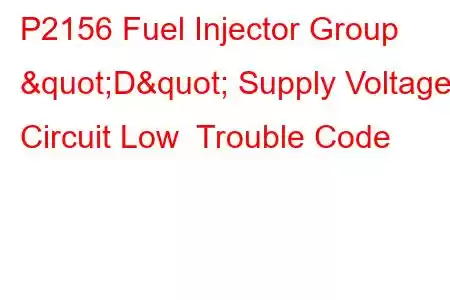P2156 Fuel Injector Group D Circuit Low
OBD-II Trouble Code Technical Description
Fuel Injector Group D Circuit Low
What does that mean?
This is a generic powertrain diagnostic trouble code (DTC) and typically applies to OBD-II vehicles. That may include but is not limited to vehicles from Dodge Ram (Cummins), GMC Chevrolet (Duramax), VW, Audi, Ford (Powerstroke), Mercedes Sprinter, Peugeot, Alfa Romeo, Nissan, Saab, Mitsubishi, etc. Although generic, the exact repair steps may vary depending on year, make, model and powertrain configuration.
Fuel injectors are an integral part of the fuel delivery systems in modern day vehicles.
Fuel delivery systems use varying amounts of components to control and monitor the volume, timing, pressures, etc. of the system in conjunction with the ECM (Engine Control Module). Fuel injectors were introduced as a replacement to the carburetor because injectors are more efficient and effective in controlling fuel delivery. As a result, they have improved our fuel economy, and engineers have been actively designing more ideal ways to increase efficiency to this design.
Given the fact that the injector's spray is controlled electronically, supply voltage is crucial in supplying fuel to the cylinders. That said, a problem in this circuit can and/or will cause significant drivability issues among other potential hazards/symptoms.
The group letter "D" in this code is used to distinguish what exact circuit the fault is referring to. To determine how this applies to your particular vehicle, you will need to refer to manufacturer specific technical information. Some examples of distinctions with injectors: Bank 1, 2, etc., paired injectors, individual injectors, etc.
The ECM illuminates the MIL (Malfunction Indicator Lamp) with P2156 and/or related codes (P2155, P2157) when it monitors a fault within the supply voltage to the fuel injectors and/or their circuits. The fact that the fuel injectors' harnesses are routed in close proximity to extreme temperatures should be noted. Because of the location of the harnesses, they are volatile to physical damage. With this in mind, I will say, most of the time, this will be a mechanical issue.
The P2156 Fuel Injector Group D Circuit Low code is active when the ECM detects a low voltage condition within the supply voltage circuit within the fuel injectors or their circuits.
What is the severity of this DTC?
Pretty severe I would say. In the field, we call a lack of fuel in the mixture being burnt, a "lean" condition. When you engine is running lean, you run the risk of causing extreme engine damage in both the immediate and distant futures. With that in mind, always keep up on your engine's maintenance. There needs to be a certain amount of diligence here, so let's keep our engines running smooth and efficient. After all, they ARE pulling our weight around to transport us on a daily basis.
What are some of the symptoms of the code?
Symptoms of a P2156 trouble code may include:
Erratic engine performance Misfire Fuel economy reduced Erratic idle Excessive smoke Engine noise(s) Lack of power Cannot climb steep hills Reduced throttle responseWhat are some of the common causes of the code?
Causes for this P2156 fuel injector group supply voltage code may include:
Defective or damaged fuel injector(s) Damaged wiring harness Internal wiring malfunction Internal ECM issue Connector problemWhat are some P2156 troubleshooting steps?
Basic Step #1
First recommended step is to locate which "group" of sensors the manufacturer is referring to. With this information, you can then find the physical location of the injector(s) and their circuits. This may involve removing numerous engine covers and/or components to gain visual access (if possible). Make sure to inspect the harness for
Read: 21


